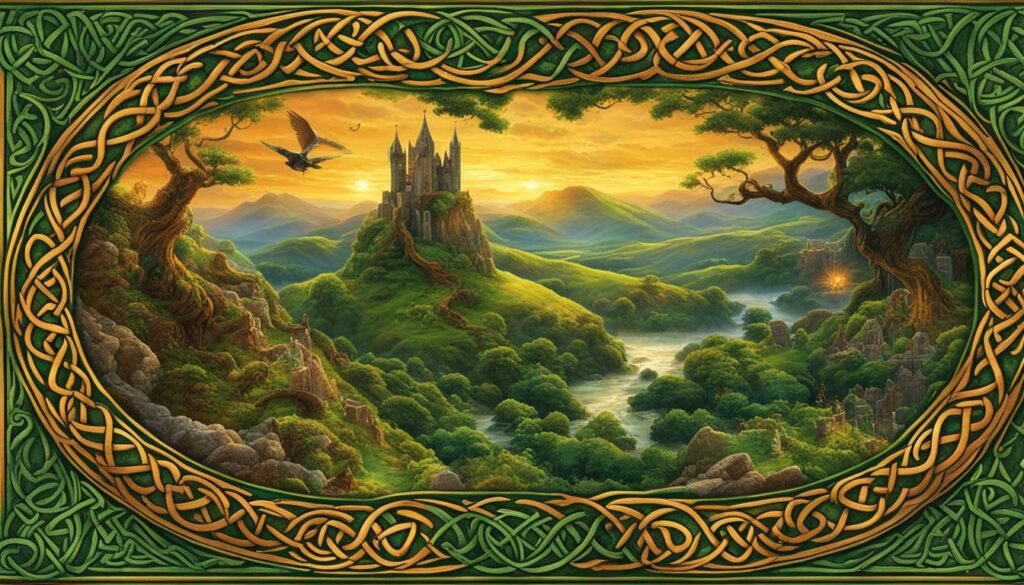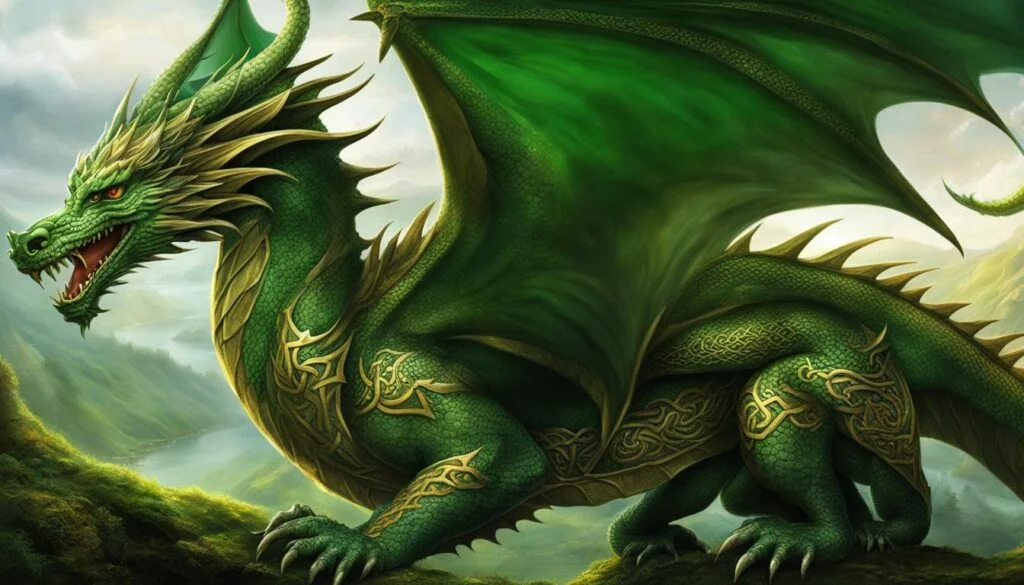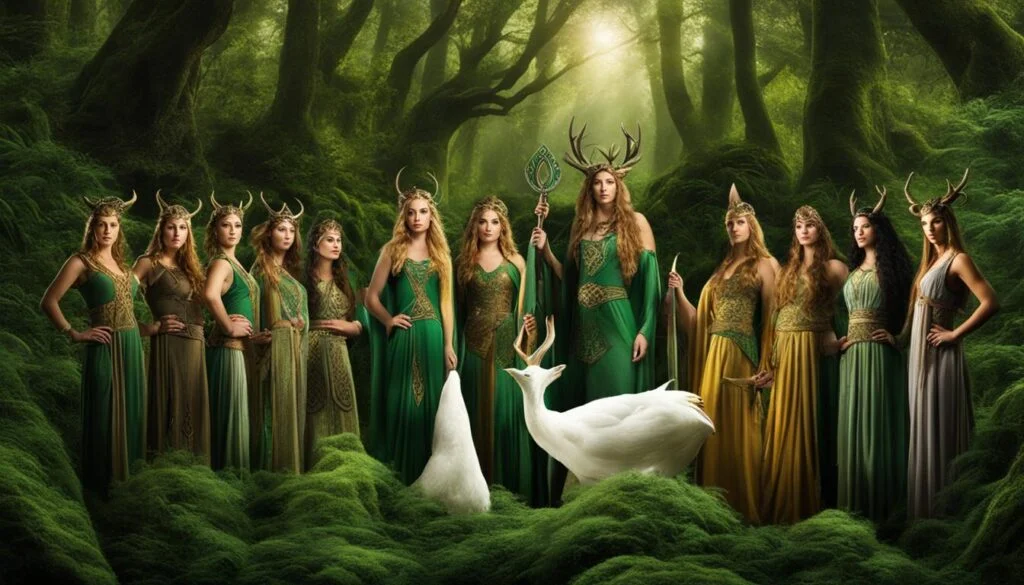Welcome to our exploration of Celtic mythology! In this article, we will dive into the origins of Celtic folklore, uncovering the rich history and captivating stories that have fascinated people for centuries. So, where does Celtic mythology come from? Let’s find out!
Celtic mythology finds its roots in the ancient Celtic tribes that once inhabited Western Europe, including present-day Ireland, Wales, Scotland, Cornwall, and Brittany. These tribes had a vibrant polytheistic religion, with a pantheon of gods and goddesses who played significant roles in their myths and legends.
The stories of Celtic mythology were primarily passed down orally, generation after generation. It wasn’t until the Middle Ages that Christian monks began recording these tales in writing, preserving them for future generations to enjoy.
Now, let’s embark on a fascinating journey through the enchanting world of Celtic mythology, where gods and goddesses reign, heroes undertake heroic quests, and mystical creatures roam.
Key Takeaways:
- Celtic mythology originated from the ancient Celtic tribes in Western Europe.
- The myths were initially passed down orally and later recorded by Christian monks.
- Celtic mythology features a rich pantheon of gods and goddesses.
- The stories have captivated audiences for centuries and continue to inspire modern works of literature and entertainment.
- Celtic mythology has had a profound influence on the Arthurian legend.
The Insular Celtic Peoples and their Mythology
The Insular Celtic peoples, including the Gaelic, Irish, Scottish, Welsh, Breton, and Cornish, have contributed significantly to the rich tapestry of Celtic mythology. These ancient tribes, spread across Western Europe, have preserved the majority of their myths in oral lore, passing down captivating stories from generation to generation.
Gaelic mythology, with its roots in Ireland and Scotland, boasts the largest written body of Celtic myths. It is a treasure trove of mystical tales that showcases the supernatural race known as the Tuatha Dé Danann, the prominent Celtic gods of Ireland. Welsh mythology, on the other hand, has its own unique charm, with characters belonging to the Plant Dôn (“Children of Dôn”) and the Plant Llŷr (“Children of Llŷr”).
These myths are filled with enchanting creatures, heroic legends, and magical landscapes. They take us on a mesmerizing journey through the realms of gods and goddesses, where quests, battles, and ancient prophecies unfold. The tales from the Insular Celtic peoples captivate our imagination and provide a glimpse into the vibrant folklore that continues to inspire us today.
Key Points:
- The Insular Celtic peoples include Gaelic, Irish, Scottish, Welsh, Breton, and Cornish tribes.
- Gaelic mythology has the largest written body of Celtic myths, with the Tuatha Dé Danann as its main focus.
- Welsh mythology features the Plant Dôn and the Plant Llŷr, adding its own unique storytelling tradition to the Celtic mythos.
- The myths from these Celtic tribes transport us to magical realms filled with gods, goddesses, and epic adventures.
Common Themes and Motifs in Celtic Mythology
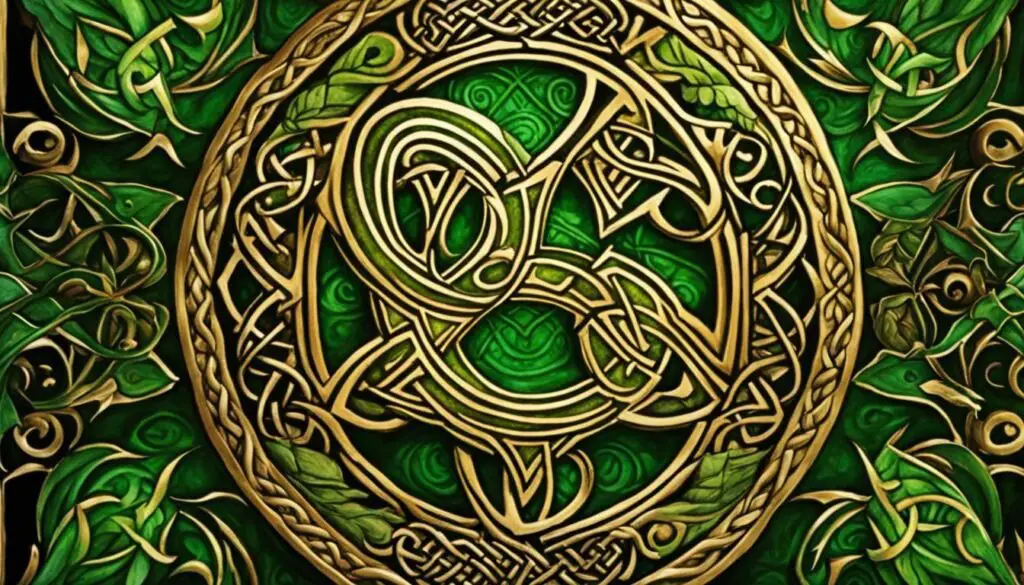
Celtic mythology is rich in common themes and motifs that add depth and intrigue to its stories. These recurring elements provide a glimpse into the beliefs and values of the ancient Celts. Let’s explore some of the most prominent themes in Celtic mythology:
1. The Otherworld
The Otherworld is a parallel realm that exists alongside our own and is inhabited by supernatural beings. It is often depicted as a fantastical and mystical place, filled with enchantment and wonder. In Celtic mythology, heroes and heroines frequently venture into the Otherworld, where they encounter magical creatures, receive guidance from wise beings, and undergo transformative experiences.
2. Sovereignty Goddess
The concept of the sovereignty goddess is a significant theme in Celtic mythology. These goddesses personify the land and the prosperity of the kingdom. They have the power to grant or withhold sovereignty from a king through marriage. The relationship between the king and the sovereignty goddess reflects the connection between a ruler’s legitimacy and the well-being of the land.
3. Shapeshifting
Shapeshifting is a common motif in Celtic mythology, where characters possess the ability to transform into various forms. This includes humans turning into animals and vice versa. Shapeshifting often serves as a means of disguise, protection, or exploration. It symbolizes the fluidity of identity and the blurring of boundaries between the human and animal worlds.
4. Magic Mist
The presence of magic mist is another recurring element in Celtic mythology. This mist is often associated with enchanted forests, sacred groves, and hidden realms. It acts as a mystical barrier, veiling the boundaries between different realms and granting access to magical experiences. The magic mist represents the liminal space between the ordinary and the extraordinary, where myth and reality intertwine.
Gauls, Celtiberians, and Greco-Roman Sources
The mythologies of the Gauls and Celtiberians, two of the continental Celtic peoples, have unfortunately not survived intact due to the conquest by the Roman Empire and subsequent conversion to Christianity. However, remnants of their rich mythological traditions can be found in Greco-Roman sources and archaeological discoveries.
Greco-Roman sources provide valuable insights into the beliefs and practices of the Gauls and Celtiberians. These sources often equate Celtic deities with their Roman counterparts, shedding light on a more unified pantheon than previously believed. Inscriptions of over 300 deities have been discovered, revealing the diverse aspects of Celtic religious beliefs.
Notable Gaulish Deities:
- Cernunnos: The horned god associated with nature, fertility, and the wild.
- Epona: The goddess of horses and fertility, often depicted as a woman riding a horse.
- Belenus: The god of the sun, healing, and light.
- Taranis: The god of thunder, often depicted with a wheel symbolizing cosmic power.
Notable Celtiberian Deities:
- Endovelicus: The god of healing, fertility, and protection.
- Arentia: The goddess associated with agriculture and fertility.
- Nabia: The goddess of water, springs, and rivers.
- Reva: The deity associated with war and combat.
Although much of the original Gaulish and Celtiberian mythology may be lost, the glimpses we have through Greco-Roman sources and archaeological evidence offer a fascinating window into the beliefs and deities of these ancient Celtic cultures.
The Mythological Cycles of Irish and Welsh Mythology
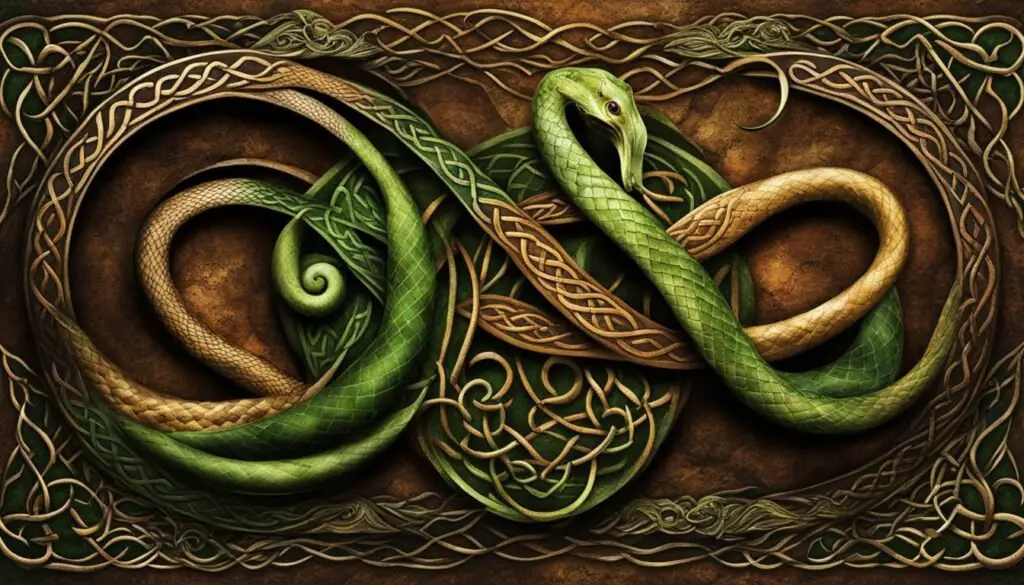
Irish mythology is a treasure trove of ancient stories and legends, encompassing a range of fascinating cycles that provide insights into the rich cultural heritage of the Celtic people. One of the most prominent cycles is the Mythological Cycle, which delves into the world of the god-like Tuatha Dé Danann and other mythical races. This cycle showcases tales and poems that explore the origins of the Celtic gods, their interactions with mortals, and their struggles for power and supremacy.
The Ulster Cycle, another significant cycle in Irish mythology, focuses on the heroic legends of the Ulaid, a warrior society of ancient Ireland. This cycle is filled with stories of epic battles, daring feats, and larger-than-life characters like the hero Cú Chulainn. Known for his supernatural strength and bravery, Cú Chulainn’s exploits form the backbone of this cycle, illustrating the ideals of honor, courage, and loyalty that were cherished by the Celtic people.
The Fianna Cycle
The Fianna Cycle offers a glimpse into the world of the mythical hero Finn and his band of warriors, the Fianna. Finn, a great leader and warrior, embarks on thrilling adventures and quests, battling supernatural creatures and defending the land from various threats. This cycle explores themes of heroism, loyalty, and the complex relationships between mortals and the supernatural, immersing readers in a world filled with magic, courage, and honor.
Welsh mythology, known as the Matter of Britain, boasts its own unique cycles and tales that are woven into the fabric of Celtic folklore. The Mabinogion, a collection of Welsh myths and legends, offers a glimpse into the lives of legendary heroes, magical creatures, and powerful enchantresses. These tales, filled with intrigue, romance, and tragedy, transport readers to a world where destiny and magic intertwine, showcasing the distinct flavor and traditions of Welsh mythology.
The Kings’ Cycles and the Welsh Triads
The Kings’ Cycles, on the other hand, comprise legends about historical and semi-historical kings of Ireland. These tales provide valuable insights into the lives of ancient rulers, their struggles for power, and the complex dynastic relationships that shaped the destiny of the Celtic kingdoms. In Welsh mythology, the Welsh Triads offer a unique perspective on the heroic deeds and noble virtues of legendary figures, encapsulating the spirit of Celtic chivalry and honor.
Celtic Mythology and Arthurian Legend
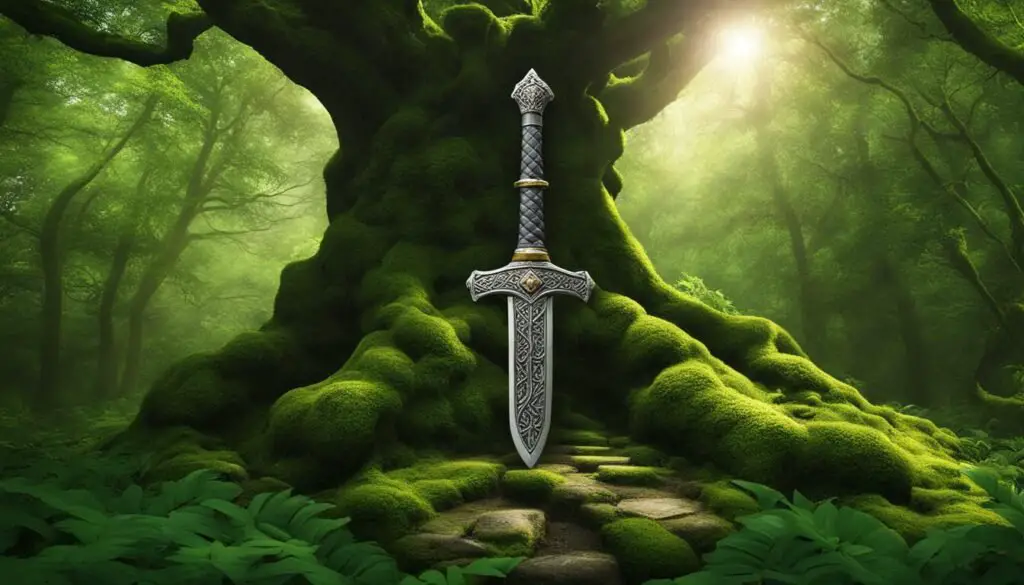
Celtic mythology has had a significant influence on the popular tales of King Arthur and the Knights of the Round Table. Many elements of Celtic myth, such as the Otherworld and mythical characters like the sovereignty goddess, have been incorporated into the Arthurian stories, adding depth and enchantment to the legendary tales. These connections between Celtic mythology and Arthurian legend highlight the enduring impact of Celtic folklore on western literature and culture.
The Arthurian legend itself has roots in the Celtic lands of Britain and Wales, where ancient Celtic legends and traditions were passed down through generations. The stories of Arthur’s heroic adventures, his quest for the Holy Grail, and his noble Knights are deeply intertwined with the mystical and magical elements of Celtic mythology.
One of the most famous characters associated with both Celtic mythology and Arthurian legend is the Lady of the Lake. In Celtic mythology, she is a supernatural being associated with water, and she possesses mystical powers and knowledge. In the Arthurian legend, the Lady of the Lake plays a pivotal role in bestowing Excalibur, the legendary sword, upon King Arthur.
Influence and Legacy
- The Arthurian legend drew inspiration from Celtic mythology, infusing the tales with enchantment and ancient wisdom.
- Celtic motifs and themes, such as the Otherworld and magical objects, add depth and intrigue to the Arthurian stories.
- The enduring popularity of Arthurian legend, fueled by its fusion with Celtic mythology, continues to captivate audiences and inspires various adaptations in literature, movies, and video games.
Through the combination of Celtic mythology and Arthurian legend, we are transported to a world of knights, wizards, and mythical creatures, where honor and chivalry reign supreme. The influence of these ancient Celtic tales has left an indelible mark on the genre of fantasy literature, ensuring their legacy lives on in the hearts and imaginations of readers and storytellers alike.
The Spread of Celtic Mythology

Ancient Celtic legends and myths have spread far and wide, transcending the boundaries of time and geography. From the ancient Celtic tribes that once roamed Western Europe, including regions that are now Ireland, Wales, Scotland, Cornwall, and Brittany, these captivating stories have captivated the imaginations of people across different lands.
The ancient Celtic tribes, known for their rich cultural heritage, passed down their myths through oral tradition. As these tales were shared from one generation to the next, they took on different flavors and nuances, influenced by the unique geography and cultural practices of each Celtic tribe. From the rolling hills of Ireland to the rugged peaks of Scotland, the ancient Celtic legends found fertile ground to take root and flourish.
Ancient Celtic Tribes and Their Mythology
- The Gaels of Ireland and Scotland
- The Celtic Britons of western Britain and Brittany
- The Cornish and Welsh people
These Insular Celtic peoples preserved the majority of their myths in oral lore, passing them on from one generation to the next. Irish mythology, with its vast wealth of written material, stands as a testament to the enduring power and popularity of Celtic myth. Welsh mythology, too, has its own unique cycles and tales, including the famous Mabinogion and the Welsh Triads. These tales have shaped the cultural identities of the various Celtic regions and continue to hold a special place in the hearts and minds of those who cherish Celtic heritage.
But Celtic mythology did not stop at the shores of the British Isles. It spread across vast lands, covering regions that are now Spain, Switzerland, and even Turkey. The ancient Gauls, one of the most famous ancient Celtic tribes, had their own rich mythology known as Gaulish mythology. Although much of this mythology did not survive the conquest by the Roman Empire, remnants can still be found in Greco-Roman sources and archaeological discoveries.
Today, these ancient Celtic legends continue to inspire and captivate modern audiences. From literature to movies and video games, the influence of Celtic mythology can be seen in popular culture. The enduring power and appeal of Celtic mythology are a testament to the timeless nature of these ancient tales, which still hold the power to transport us to a world of magic and wonder.
The Gods and Goddesses of Celtic Mythology
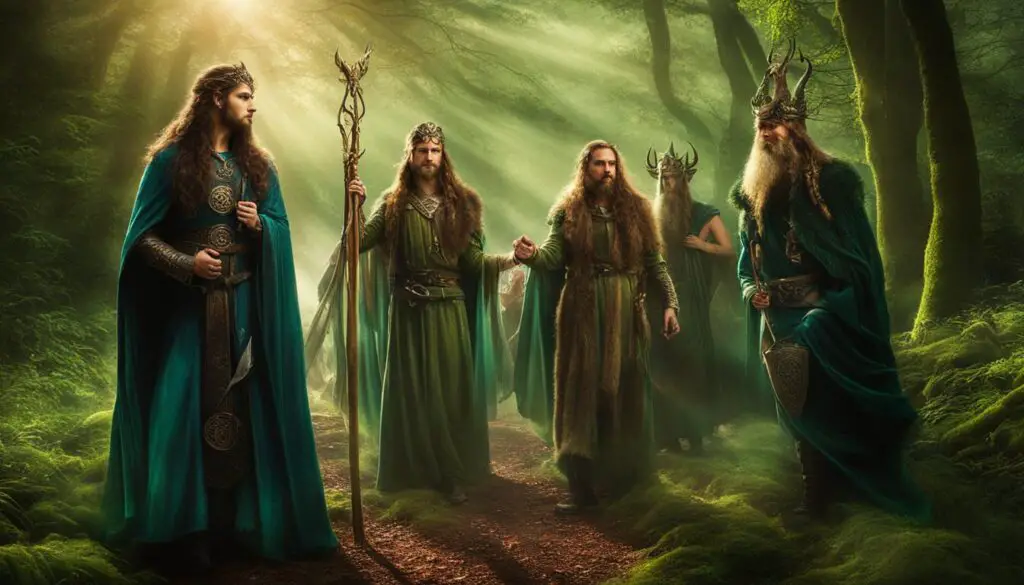
Celtic mythology is rich with a diverse pantheon of gods and goddesses. These deities played significant roles in the ancient Celtic religion and were revered by the Celts across their territories. Let’s explore some of the notable gods and goddesses in Celtic mythology:
1. The Dagda
The Dagda, often referred to as the “Good God,” was the chief god of the Celtic pantheon. He possessed great strength and wisdom, and his role encompassed fertility, agriculture, and abundance. The Dagda was often depicted as a bearded figure carrying a magical club and a cauldron of plenty, representing his association with prosperity and the cycles of life.
2. Lugh
Lugh was a prominent god associated with skills, craftsmanship, and leadership. Known as the “Master of All Arts,” he was revered for his prowess in combat and his ability to excel in various crafts. Lugh was also linked to the harvest, and his festival, known as Lughnasadh, celebrated the bounty of the land.
3. The Morrígan
The Morrígan was a powerful goddess associated with war, fate, and sovereignty. She often appeared as a triple goddess, representing different aspects of her character: Macha, the mother and protector; Badb, the fury and battle goddess; and Nemain, the war goddess. The Morrígan played a pivotal role in shaping the outcomes of battles and had the ability to shape-shift into different forms.
4. Brigid
Brigid was a revered goddess associated with healing, fertility, and poetry. Known as the “Exalted One,” she represented the nurturing aspects of life and was particularly venerated by women. Brigid was also linked to the natural world and the changing seasons, embodying the spirit of spring and the awakening of life.
These are just a few examples of the gods and goddesses that played prominent roles in Celtic mythology. The diverse pantheon reflects the rich and complex religious beliefs of the ancient Celts, and their stories continue to captivate and inspire us today.
Sacred Spaces and Rituals in Celtic Mythology
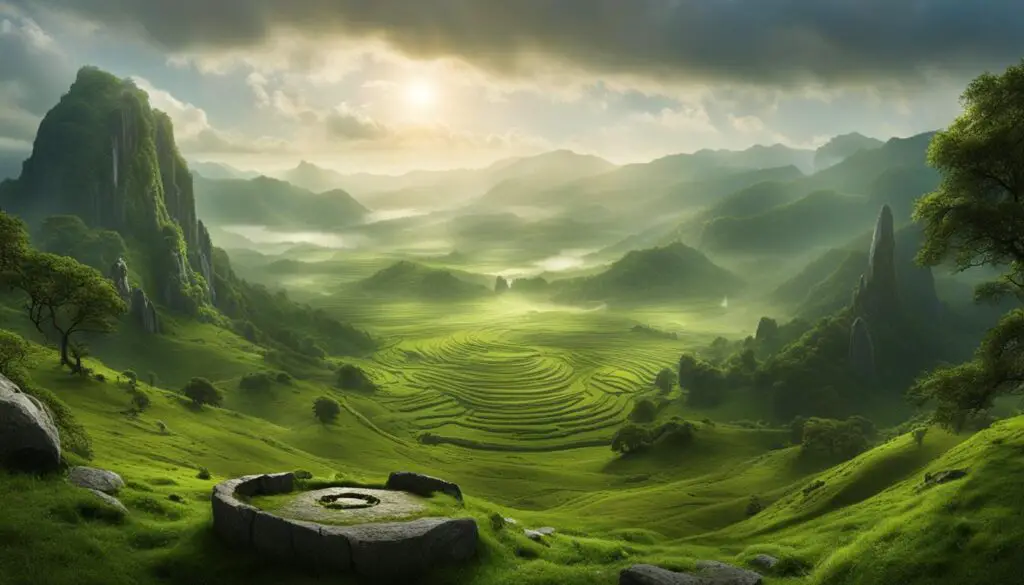
Within Celtic mythology, sacred spaces hold a significant place in the religious practices of the ancient Celts. These spaces are often found in natural settings such as groves and caves, which were considered to be consecrated areas. The Celts believed that these sacred spaces were gateways to the Otherworld, a parallel realm inhabited by supernatural beings and deities.
The druids, the revered religious leaders of the Celts, played a crucial role in leading rituals and ceremonies within these sacred spaces. They were responsible for preserving and passing on the traditions, myths, and wisdom of the Celtic people. Druids would conduct ceremonies and offer sacrifices to the gods, seeking their favor and guidance.
Celtic rituals were deeply tied to the natural world and its cycles. They celebrated the changing seasons, the phases of the moon, and the agricultural cycles. These rituals honored the gods and goddesses, invoked their blessings, and ensured the prosperity of the land and the people. Votive offerings and sacrifices were made during these ceremonies, symbolizing the connection between the human and divine realms.
In conclusion, sacred spaces and rituals held a central place in Celtic mythology, serving as a means to connect with the divine and honor the gods and goddesses. These spaces, often found in natural settings, were considered sacred gateways to the Otherworld. Guided by the druids, the ancient Celts conducted rituals that celebrated the cycles of nature and invoked the blessings of the gods. Through these rituals, the Celtic people sought to maintain harmony with the natural world and ensure the prosperity of their communities.
Conclusion
In conclusion, Celtic mythology has a fascinating history that traces back to the ancient Celtic tribes. These myths originated from the polytheistic beliefs of the Celts and were passed down orally before being recorded in writing by Christian monks in the Middle Ages. The rich and diverse collection of stories in Celtic mythology continues to captivate audiences today, inspiring literature, movies, and even the enduring popularity of Arthurian legend.
The origins of Celtic mythology are deeply rooted in the ancient Celtic tribes, and the myths reflect their complex religious beliefs. The gods and goddesses of Celtic mythology, with over 300 recorded deities, highlight the diverse nature of this ancient folklore. From the chief god Dagda to the war and sovereignty goddess Morrígan, each deity plays a significant role in the mythological stories.
Celtic mythology also features common themes and motifs such as the Otherworld, shapeshifting, and magic mist. These recurring elements add depth and intrigue to the stories while showcasing the enduring impact of Celtic folklore on Western culture. Moreover, Celtic mythology has spread across various regions, including Spain, Switzerland, and Turkey, showcasing its wide geographic influence.
The history of Celtic folklore is a testament to its lasting appeal. From its origins in the ancient Celtic tribes to its modern-day revival, Celtic mythology continues to inspire and captivate audiences around the world. Whether through ancient tales or modern adaptations, the history and origin stories of Celtic mythology remain a source of fascination and wonder.
FAQ
Where does Celtic mythology come from?
Celtic mythology originated from the ancient Celtic tribes found throughout Western Europe, including regions that are now Ireland, Wales, Scotland, Cornwall, and Brittany.
Who preserved the majority of Celtic myths?
The Insular Celtic peoples, including the Gaels of Ireland and Scotland, the Celtic Britons of western Britain and Brittany, and the Cornish and Welsh people, preserved the majority of Celtic myths in oral lore.
What are some common themes in Celtic mythology?
Common themes in Celtic mythology include the Otherworld, sovereignty goddesses, shapeshifting, magic mist, sacred trees, and the concept of the wasteland.
What happened to continental Celtic mythologies?
The mythologies of continental Celtic peoples, such as the Gauls and Celtiberians, did not survive their conquest by the Roman Empire, the loss of their Celtic languages, and their subsequent conversion to Christianity.
What are the different cycles in Irish mythology?
Irish mythology is conventionally grouped into cycles, including the Mythological Cycle, Ulster Cycle, Fianna Cycle, and Kings’ Cycle.
How does Celtic mythology influence Arthurian legend?
Celtic mythology has had a significant influence on Arthurian legend, with elements such as the Otherworld and mythical characters like the sovereignty goddess being incorporated into the Arthurian stories.
Where did Celtic mythology spread?
Celtic mythology spread across a wide geographic area, covering regions that are now Spain, Switzerland, Turkey, as well as the Celtic lands of Ireland, Wales, Scotland, Cornwall, and Brittany.
Who are some notable gods and goddesses in Celtic mythology?
Notable gods in Celtic mythology include the Dagda, the chief god of the Celtic pantheon, and Lugh, associated with skill and craftsmanship. Goddesses like the Morrígan, associated with war and sovereignty, and Brigid, associated with healing and poetry, also play important roles.
Where were sacred spaces in Celtic mythology found?
Sacred spaces in Celtic mythology were often found in natural settings such as groves and caves, which were considered to be consecrated areas.
How has Celtic mythology influenced modern culture?
Celtic mythology has experienced a revival in the past century and continues to inspire modern works of literature, movies, and video games.


